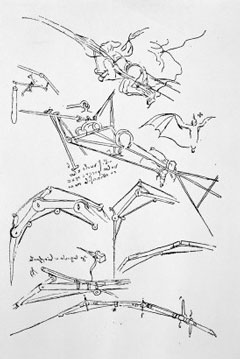|
The Ingenuity behind
Leonardo Da Vinci Inventions
"Life is pretty simple: You do some stuff. Most fails. Some works. You do more of what works. If it works big, others quickly copy it. Then you do something else. The trick is the doing something else."
--Leonardo da Vinci
Besides being one of the most famous artists to ever walk the planet, Leonardo da Vinci was also a prolific inventor and engineer. Many of his inventions, depicted in drawings and journals found only after his death, were mainly theoretical in nature and never actually realized (with a few exceptions.)
A study of Leonardo da Vinci inventions indicates a mind that was literally centuries ahead of its time. Leonardo lived and worked in the late 15th and early 16th centuries, a time when technological progress and adherence to scientific and engineering principles such as leverage, pulleys, cranks, gears, parallel linkage, momentum, centripetal force and the aerofoil were unheard of. While many of his inventions would have been dysfunctional if built, his drawings inspired actual working copies of the flying machine, the machine gun, and various other outstanding contraptions that would not appear until the 19th century.
 Working
Inventions
Working
Inventions
Leonardo da Vinci inventions had tremendous impact on engineering concepts,
manufacturing approaches, and the war industry. He was contracted by Italian
dignitary and nobleman Ludovico il Moro to create military equipment.
He invented a machine that protected soldiers who were trying to charge a wall, a rudimentary tank that protected infantry, cannons that shot devastating projectiles, and a machine that could kill by rotating a series of scythes, similar to farming equipment.
Da Vinci made significant contributions to the field of civil engineering. Some of the most useful Leonardo da Vinci inventions were hydraulic machines that served various functions. The man’s advanced understanding of water flow and how its power could be used, led him to design the basic water wheel engine. His plans were meticulous in the construction of bridges, including portable bridges that were intended to enable armies to cross rivers.
Theoretical Inventions
Because Leonardo da Vinci was so far ahead of his time, many of his creations
came a little too early in history to be viewed as practical by his contemporaries.
For example, he was fascinated by the idea that technology could put man
in flight. He designed an early hang-glider that could have functioned
had it ever been constructed. Although he outlined the plans for the world’s
first helicopter, the machine could not have flown as the propellers turned
against the direction of the rotors. His aspirations led him to design the world’s first parachute. Legend has it that a hawk flew over
his cradle when he was an infant, permanently affecting his vivid imagination,
which would later concoct various concepts of aviation.
Leonard tried to invent a device that enabled men to walk on water, but his attempt was futile. He also created the world’s first key-and-bow musical instrument, which was never fully realized.
Undoubtedly, Leonardo da Vinci had a wild and restless mind that fostered literally hundreds of schematics for possible inventions. And although many of his ideas were considered far-fetched, and some of his creations never actualized, Leonardo da Vinci inventions had an enormous impact and served as inspiration for the inventors of the future and on Western technology. From da Vinci’s in-depth study of the mechanics of flight to his service as a one-man engineer contributing to the war efforts of the time, he is remembered as one of humankind’s greatest minds.
